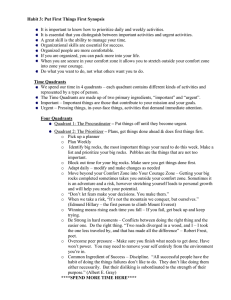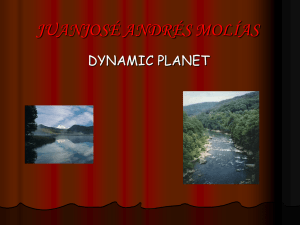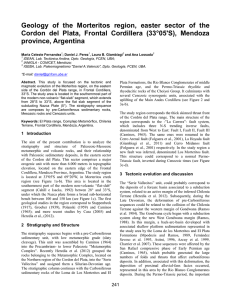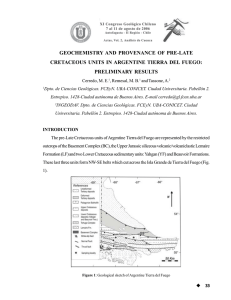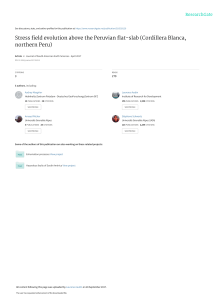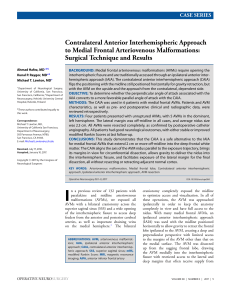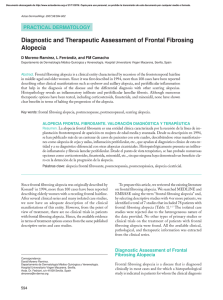Geochemistry of Upper Palaeozoic-Lower Triassic granitoids of the
Anuncio
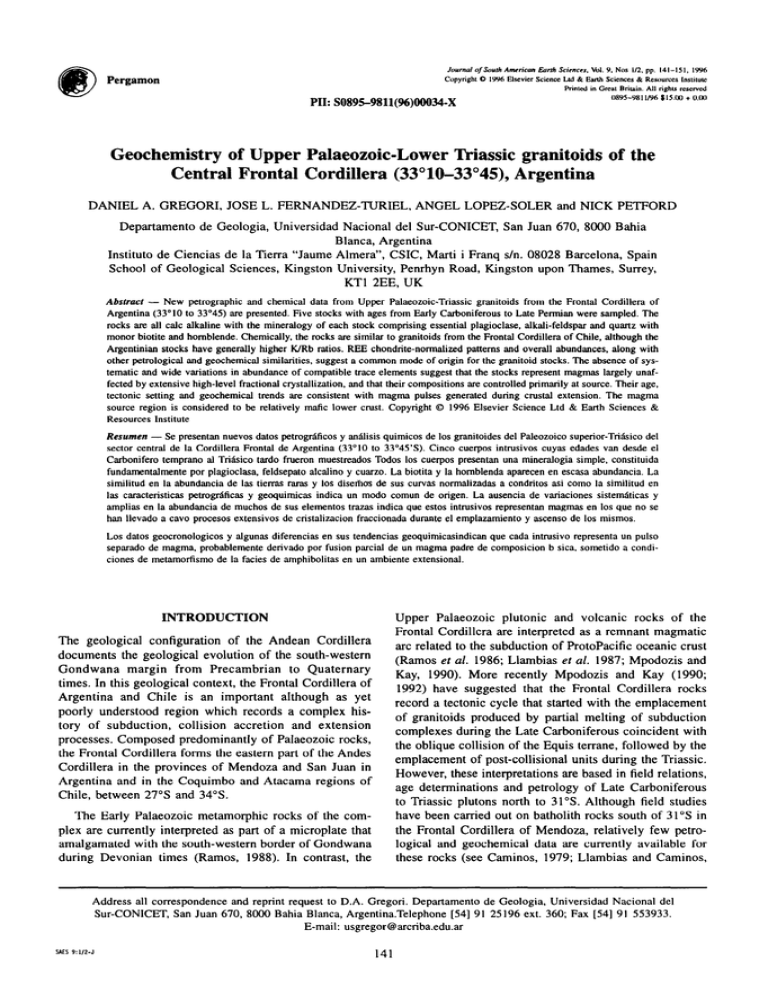
Juurnd of South Amrricon Earth Sciences, Vol. Y. Nm 112. pp. 141-151, IYY6 Copyright 0 1% Elsevier Science W C Earth Sciencea & Resources lnstiwle Printed in Great Britain. All rights resewed IMYS-Y8l I/Y6 Sl5.00 + O.(X) Pergamon PII: s0895-9811(%)ooo34-x Geochemistry of Upper Palaeozoic-Lower Triassic granitoids of the Central Frontal Cordillera (33”10-33’49, Argentina DANIEL A. GREGORI, JOSE L. FERNANDEZ-TURIEL, ANGEL LOPEZ-SOLER and NICK PETFORD Departamento de Geologia, Universidad National del SW-CONICET, San Juan 670, 8000 Bahia Blanca, Argentina Instituto de Ciencias de la Tierra “Jaume Almera”, CSIC, Marti i Franq s/n. 08028 Barcelona, Spain School of Geological Sciences, Kingston University, Penrhyn Road, Kingston upon Thames, Surrey, KTl 2EE, UK Abstract - New petrographic and chemical data from Upper Palaeozoic-Triassic granitoids from the Frontal Cordillera of Argentina (33”lO to 33”45) are presented.Five stocks with ages from Early Carboniferous to Late Permian were sampled. The rocks are all talc alkaline with the mineralogy of each stock comprising essential plagioclase, alkali-feldspar and quartz with monor biotite and hornblende. Chemically, the rocks are similar to granitoids from the-Frontal Cordillera of Chile, although the Argentinian stocks have generally higher WRb ratios. REE chondrite-normalized patterns and overall abundances,along with other petrological and geochemical similarities, suggesta common mode of origin for the granitoid stocks.The absenceof systematic and wide variations in abundanceof compatible trace elements suggestthat the stocks represent magmas largely unaffected by extensive high-level fractional crystallization, and that their compositionsare controlled primarily at source. Their age, tectonic setting and geochemical trends are consistent with magma pulses generated during crustal extension. The magma source region is considered to be relatively matic lower crust. Copyright 0 1996 Elsevier Science Ltd & Earth Sciences & Resources Institute Resumen - Se presentannuevosdatos petrogdficos y analisis quimicos de 10sgranitoidesde1 Paleozoic0 superior-TriGco de1 sector central de la Cordillera Frontal de Argentina (33”lO to 33”45’S). Cinco cuerpos intrusivos cuyas edades van desde el Carbonifero temprano al Trihico tardo frueron muestreadosTodos 10s cuerpos presentan una mineralogia simple, constituida fundamentalmentepor plagioclasa, feldsepato alcalino y cuarzo. La biotita y la homblenda aparecen en escasaabundancia. La similitud en la abundancia de las tierras rams y 10s disethosde sus curvas normalizadas a condritos asi coma la similitud en las caracteristicas petrogrtificasy geoquimicas indica un modo comun de origen. La ausencia de variaciones sistematicasy amplias en la abundancia de muchos de sus elementos trams indica que estos intrusivos representanmagmas en 10sque no se han llevado a cave procesosextensivos de cristalizacion fraccionada durante el emplazamiento y ascensode 10s mismos. Los datos geocronologicosy algunas diferencias en sus tendenciasgeoquimicasindicanque cada intrusivo representaun pulse separado de magma, probablementederivado por fusion partial de un magma padre de composition b sica, sometido a condiciones de metamortismo de la facies de amphibolitas en un ambiente extensional. INTRODUCTION Upper Palaeozoic plutonic and volcanic rocks of the Frontal Cordillera are interpreted as a remnant magmatic arc related to the subduction of ProtoPacific oceanic crust (Ramos et al. 1986; Llambias et al. 1987; Mpodozis and Kay, 1990). More recently Mpodozis and Kay (1990; 1992) have suggested that the Frontal Cordillera rocks record a tectonic cycle that started with the emplacement of granitoids produced by partial melting of subduction complexes during the Late Carboniferous coincident with the oblique collision of the Equis terrane, followed by the emplacement of post-collisional units during the Triassic. However, these interpretations are based in field relations, age determinations and petrology of Late Carboniferous to Triassic plutons north to 31”s. Although field studies have been carried out on batholith rocks south of 31”s in the Frontal Cordillera of Mendoza, relatively few petrological and geochemical data are currently available for these rocks (see Caminos, 1979; Llambias and Caminos, The geological configuration of the Andean Cordillera documents the geological evolution of the south-western Gondwana margin from Precambrian to Quaternary times. In this geological context, the Frontal Cordillera of Argentina and Chile is an important although as yet poorly understood region which records a complex history of subduction, collision accretion and extension processes. Composed predominantly of Palaeozoic rocks, the Frontal Cordillera forms the eastern part of the Andes Cordillera in the provinces of Mendoza and San Juan in Argentina and in the Coquimbo and Atacama regions of Chile, between 27”s and 345. The Early Palaeozoic metamorphic rocks of the complex are currently interpreted as part of a microplate that amalgamated with the south-western border of Gondwana during Devonian times (Ramos, 1988). In contrast, the Address all correspondence and reprint request to D.A. Gregori. Departamento de Geologia, Universidad National del Sur-CONICET, San Juan 670, 8000 Bahia Blanca, Argentina.Telephone [54] 91 25196 ext. 360; Fax [54] 91 553933. E-mail: [email protected] UES9:W-J 141 D.A. GREGORI 142 1987). Radiometric ages (K-Ar, Rb-Sr) from the Frontal Cordillera Composite Batholith record a long magmatic event that extends from the Early Carboniferous to the Triassic, and extrapolation of current tectonic models to other regions to the Frontal Cordillera of Mendoza may not be applicable without first undertaking detailed field and chemical studies of these rocks. In this paper we present new petrological and geochemical data on granitoid stocks exposed from 33”lO to 33”45 in the Frontal Cordillera of Argentina, and attempt to determine their origin and possible tectonic setting. Preliminary comparisons are also made with rocks exposed in the Frontal Cordillera of Chile and Argentina north of 31”s. GEOLOGICAL SETTING Upper Palaeozoic-Triassic intrusive rocks of the Frontal Cordillera of northern Mendoza province that com- et al. prise the Frontal Cordillera Composite Batholith were first described by Polanski (1958). The batholith has a regional N-S elongation, extending for 130 km southward to Mendoza River, varying in width from 20 km at the Cordon de1 Plata to 40 km in the Cordon del Portillo (Fig. 1). Several plutons and stocks were mapped and described by Caminos (1967) and Polanski (1972) with K-Ar and Rb-Sr radiometric ages reported by Dessanti and Caminos (1967) and Caminos et al. (1979). The La Quebrada de Guevara, La Carrera, La Cuchilla de las Minas and Santa Clara Stocks form the eastern side of the Cordon de1 Plata, whereas stocks of the Cuchilla de Guarguaraz area (the Los Tabanos Stocks) were mapped by Polanski (1972) and studied by Bjerg et al. (1990). In the Cordon del Portillo area, the Las Cuevas, Las Delicias, Cerro Punta Negra, Quebrada Portillo and Cerro Punta Blanca Stocks have also been recognized. In the Cuchilla de Guarguarazand Cordon de1 Portillo the stocks .____ _I 1 I I 1:‘:‘;:’ m U \ \- Carboniferous 1 Sedimentites 1 Basaltic rocks etamorphi cl %. Punta Blanca Stock 7Punta NegraStock Portillo YY”“““” ” Y” Y”” Y”” ““V “V” Y” “V “Y” > Fig. 1. Simplified geological map of the Frontal Cordillera between 33”lO’ S to 33”45’ S showing location of major granitoid stocks. Geochemistry of Upper Palaeozoic-Lower Triassic granitoids of the Central Frontal Cordillera intrude metamorphic basement comprised of phyllites, schists, marbles and quartzites, and greeschist facies, serpentinized ultrabasic rocks. Several phases of deformation and thermal effects relating to granitic intrusion have been recognized (Bjerg et al. 1990). Radiometric age determinations (Caminos et al. 1979) suggest an episode of regional metamorphism with a minimum age of 500 ? 50 Ma. To the eastern side of the Cordon de1 Plata is the Early to Late Carboniferous El Plata Formation (Caminos, 1965; Polansky, 1972), comprised of conglomerates, sandstones and pelites deposited in a shallow to deep water marine environment. These rocks were intruded by the La Quebrada de Guevara and La Carrera Stocks, and subsequently overlain by Permian to Triassic andesitic and rhyolitic lavas of the Choiyoi Group. During field mapping, Polanski (1964; 1972) divided the igneous rocks of the Frontal Cordillera of Mendoza province on field relationships into two plutonic-volcanic associations, the Mesovariscian Plutonic-Volcanic Association and the Tardiovariscian Plutonic-Volcanic Association. In the former, Polanski (1972) described a general intrusive trend from gabbros and tonalites to granodiorites, and a volcanic trend from andesites and dacites to rhyodacites and rhyolites. The Tardiovariscian PlutonicVolcanic association comprise granitic and granodioritic rocks as well as porphyritic granitic and rhyolitic rocks. However, systematic radiometric dating (Caminos et al. 1979) has demonstrated at least three intrusive events in the area. The first, assigned to the Somuncur phase by Caminos et al. (1988) is represented by the Cerro Punta Blanca Stock with radiometric ages of 348 f 35 Ma (RbSr) and 337 f 15 Ma (K-Ar). The second event, assigned to the San Rafael phase, is represented by the Quebrada Portillo Stock (Rb-Sr 264 + 8 Ma; K-Ar 291 + 10 Ma). The final event includes the Quebrada de Guevara (K-Ar 23 1 + 1lMa, 202 f 10 Ma) and the Punta Negra (K-Ar 234210 Ma) Stocks. This magmatic event was assigned to the Huarpes phase by Caminos et al. (1988). From a geotectonic standpoint it is generally accepted that the Frontal Cordillera igneous rocks represent a magmatic belt located along the Pacific margin of Gondwana (Frutos and Tobar, 1975; Herve et al. 1981; Ramos et al. 1984; Caminos et al. 1988). The Devonian to Lower Carboniferous tonalites and granodiorites are interpreted as a magmatic arc which shifted compositionally towards granites and granodiorites during Permian and Triassic times (Ramos et al. 1984; Herve et al. 1987). Detailed work on the magmatic units in the northern segment of the Frontal Cordillera of Chile have revealed a distinct tectonic setting for these rocks. Thus, Mpodozis and Kay, (1990, 1992) suggest that the source of the oldest units of the Late Carboniferous-Early Permian Elqui Complex represent a magmatic arc associated with Late Carboniferous subduction, while the youngest units are syncollisional granites related to uplift, crustal shortening and thickening during the San Rafael deformational event. This Late Permian to Triassic plutonism is considered post-collisional, related to underplating of basalt magmas during lithospheric thinning and crustal relaxation. The 143 Late Permian Colangeil Batholith the Frontal Cordillera of Argentina is considered by Llambias and Sato (1990) to have formed in a post-subduction extensional regime during melting of thickened crust by underplating basaltic magmas. Chemical Procedure Samples of the Gabbroic Complex cropping out in Arroyo Casas, Guevara and Los Tabanos Stocks and Cordon de1 Portillo bodies (Cerro Punta Blanca, Cerro Punta Negra, Quebrada Portillo), collected mainly through eastwest traverses along arroyos, were selected for analysis of major and trace elements. Major and trace elements were analysed by X-ray fluorescence using common USGS and French geostandards at “Jaume Almera” Institute, Barcelona, Spain. REE and trace elements were determined by ICP-MS techniques at Royal Holloway and Bedford New College, University of London, UK. Techniques and standards are given in Jarvis (1992). Results are shown in Table 1. PETROGRAPHICAL AND CHEMICAL CHARACTERISTICS OF THE FRONTAL CORDILLERA ROCKS (33”10-33”45S) In the following discussion, the igneous rocks of the Frontal Cordillera of Mendoza are described in order of younging. The basic rocks in the Arroyo Casas are considered Early Carboniferous in age, due to their close occurrance with marine Carboniferous rocks. The Cerro Punta Blanca Stock has an Early Carboniferous age, and we assign the same age to Los Tabanos Stock on the basis of field relationships, petroghapy, chemical composition and tectonic setting. Both thus belong to the Somuncur Phase. Radiometric dating implies the Quebrada Portillo Stock is Late Carboniferous to Early Permian in age. The youngest strocks, Guevara and Cerro Punta Negra, have Middle to Late Triassic radiometric ages. The Basic Rocks of the Arroyo Casas The basic rocks from the Arroyo Casas from several small (up to hundred of meters long and up to 20 m wide) units elongated NE-SW interbedded with the El Plata Formation (Lower Carboniferous) in the eastern side of the Cordon de1 Plata. They were mapped by Polanski (1972) as the Gabbroic Complex, the lowest unit of the Mesovariscian Plutonic-Volcanic Association. They are medium to fine grained rocks, dark grey in colour. Rocks from the margins of the basic units contain acicular radiating and curved actinolite, possibly after hornblende, set in a fine groundmass of epidote, quartz and magnetite. No olivine exists, but serpentine minerals are present. Towards their centres the rocks are composed of hornblende, actinolite, diopside, plagioclase and interstitial quartz showing a microcrystalline texture. No age determinations have been made on these rocks, but a Lower Carboniferous age is assumed due to their held relationships with the El Plata Formation. D.A. GREGORI 144 et al. Table 1 Arroyo Casas Basalts Sample Name AL-3AC AL-QAC AL-5AC Guevara Stock AL-GAC AL-IG AI-7G AL-2G SiO2 45.00 46.08 44.42 63.36 70.60 Ti02 1.71 2.18 1.23 2.30 0.59 0.41 0.50 Al203 16.08 13.51 12.58 15.09 14.73 14.85 FeO' 15.18 1421 12.91 1481 13.87 3.65 2.68 3.00 MnO 0.16 0.08 0.70 0.09 0.05 0.07 M@ CaO 7.36 7.28 7.15 7.25 1.55 1.06 1.30 9.75 11.26 11.80 4.59 5.52 4.77 4.60 1.05 3.80 4.06 3.77 3.85 0.13 45.90 67 30 1.21 101 13.99 1.93 0.18 0.41 0.43 P205 0.11 0.10 0.20 2.21 0.67 1.12 0.22 0.70 0.15 LOI 0.18 1.15 0.59 0.15 0.32 0.40 98.95 97.40 97.72 98.15 99.42 99.59 99.87 57 69 230 50 13 60 10 11 240 53 50 7 Na20 KZO total co V 117 249 Cl0 1 89 CU Pb nd nd nd nd nd nd nd nd 16 14 15 Zn nd nd nd nd 57 27 32 307 11 92 87 94 70 60 686 434 55 411 534 371 402 18 1.96 18 1.40 S 310 310 309 Rb 8 10 18 69 122 243 Ba Sr Ga Ta Nb Hf Zr Y L 13 103 111 290 16 320 0.47 2.81 19 1.31 6.7 0.90 8.4 6.1 11.2 11.0 3.05 2.48 6.7 4.17 11.1 3.04 3.95 3.06 3.10 83 121 35 76 86 136 28 0.93 20 127 26 130 23 11.25 10.97 11.01 0.39 2.40 3.86 3.40 18.00 54.10 201 19 0.58 19 Th 32 1.14 1.33 24 0.81 U 0.44 0.61 0.40 La Ce Pr 0 17 9.14 5.47 4.51 5.84 19.72 17.69 22.95 26.95 20.35 22.50 56.75 53.10 2.38 3.61 1.80 2.33 6.20 5.65 6.10 13.10 6.09 9.89 4.34 12.50 22.15 Sm 11.41 4.87 5.35 5.76 23.15 5.18 22.95 5.40 Eu 1.76 1.98 Gd Tb 4.22 1.69 5.41 1.63 3.92 1.68 4.56 0.85 5.43 0.82 6.54 Nd DY Ho Er Tm Yb Lu Cl 1.14 2.48 0.49 3.64 1.04 1.55 3.24 0.88 4.00 3.88 0.72 4.13 4.89 0.86 2.28 0.43 0.83 3.16 0.48 0.47 0.71 2.96 0.41 62.89 84.20 207.70 2.28 1.76 0.73 4.29 0.88 4.36 0.76 3.55 4.60 3.87 0.79 2.58 0.84 0.80 2.61 3.26 0.52 1.61 2.71 0.70 3.42 0.32 100.00 0.31 153.70 0.53 0.32 133.24 143.00 The basic bodies range from 44 to 47 wt% Si02. They are metaluminous (AS1 = 0.43-0.88) low-K tholeiites (Table l), with relatively high MgO and CaO, typically 7.2 and 10 wt% respectively (Fig. 2). From their distribution on mantle trace elements discrimination diagrams (e.g. Pearce, 1982; Shervais, 1982; Myers and Breitkopf, 1989, and Fig. 3), we interpret the basalts at Arroyo Casas to be derived from an oceanic mantle source. An E-MORB signature is indicated by their REE patterns, which although essentially flat at 10-30 times chondrite show some LREE enrichment (Fig. 5). Given the close 0.60 2.54 asscoiation of these rocks with Carboniferous marine sediments it is probable that they represent basic material erupted in an extensional or marginal basin setting. Cerro Puntn Blanca Stock The Cerro Punta Blanca is an irregular stock 9 km wide and 7 km long, intruding metamorphic rocks in the eastern side of Cordon de1 Portillo. It has a medium to coarse grained equigranular to porphyritic texture, with locally developed pegmatitic veins. Rhyolitic dykes and 145 Geochemistry of Upper Palaeozoic-Lower Triassic granitoids of the Central Frontal Cordillera Table 1 kontdl Los Tgbanos SampleName 0106T Stock 0406T Quebrada 0706T 0906T 1106T 0222QP Portillo Stock 0422QP 0223QP 0523QP Si02 64.11 61.21 il.31 64.60 0.41 0.82 0.01 0.57 68.36 0.48 65.27 0.56 59.31 0.58 61.88 0.54 76.11 TiO2 Al203 FeO* 15.21 15.58 10.01 16.75 15.10 13.98 15.46 3.27 4.33 4.09 3.55 15.29 0.29 2.85 2.94 MnO 0.04 0.08 0.05 0.04 0.01 3.22 0.04 15.80 2.92 0.05 0.08 0.21 MgO CaO Na20 KZO P205 LOI total 2.05 1.21 1.45 1.79 0.12 1.03 1.47 1.30 I.22 3.75 5.19 4.08 2.37 4.79 0.74 3.05 3.20 4.77 6.10 5.21 5.39 1.70 5.59 2.79 5.54 3.91 3.50 3.61 4.44 3.23 3.50 4.49 4.30 4.42 4.49 4.99 0.31 0.18 0.15 0.25 0.01 0.21 0.24 0.25 0.13 1.30 I.74 0.66 0.91 1.29 0.60 2.04 5.22 99.42 99.36 99.35 99.39 1.96 100.73 99.00 100.78 99.50 98.57 3 5 7 4 I 43 59 54 55 13 16 109 co V cu Pb Zn S Rb Ba Sr Ga Ta Nb Hf Zr Y Th U La Ce Pr Nd Sm Eu Gd Tb DY Ho Er Tm Yb Lu Cl 11 8 7 70 50 1 104 1 6 71 714 38 13 48 12 64 63 48 54 78 171 13 0.50 83 2 10 59 22 30 34 51 56 94 123 39 Ill 73 83 388 67 35 54 86 I8 39 524 438 1209 82 799 224 1040 549 52 247 105 581 915 546 592 99 947 612 581 20 24 21 132 18 0.14 0.64 23 0.75 11.8 458 21 0.86 21 225 I3 0.79 1.09 22 0.63 II.? 7.7 12.4 10.6 4.59 6.56 6.34 2.68 2.7 3.50 185 297 139 33 24 131 14 26 12.23 7.01 2.24 2.53 12.07 1.63 15 7.04 I.34 0.68 1.52 8.8 10.1 6.35 4.09 193 140 12 15 5.06 1.26 11.09 2.60 9.20 12 15.62 2.06 4.51 27.26 63.10 5.63 9.5 4.10 283 191 4 14 0.95 0.41 24.47 6.29 14.14 44.12 0.20 40.32 59.60 26.10 40.90 3.95 34.00 12.55 84.65 5.76 2.60 2.99 0.53 9.14 6.57 23.30 5.25 1.47 10.53 3.19 1.42 19.00 4.52 13.85 2.98 2.66 25.70 1.06 0.87 1.97 0.48 57.60 6.20 3.75 2.31 0.49 3.90 0.68 2.66 0.38 1.04 0.18 2.73 0.49 3.70 1.10 0.20 2.63 1.50 2.47 2.22 0.62 I.66 0.38 2.48 0.28 2.22 0.40 0.48 4.06 0.46 2.10 0.37 0.21 102.83 132.94 292.08 312.07 0.74 3.53 0.83 0.45 161.75 0.30 faults (striking N160”) cut the stock. Xenoliths of metamorphic rocks are found near the margin. The Cerro Punta Blanca Stock, which ranges in composition from quartz monzonite to monzogranite, gives radiometric ages of 348 f 35 Ma (Rb-Sr) and 337 f 15 Ma (K-Ar). Quartz, feldspar and plagioclase are the main minerals present. Biotite is common but hornblende is scarce. Muscovite is present in one sample infilling late-stage veins. Quartz shows undulose extinction, and zoned plagioclase with altered cores are common. The Cerro Punta Blanca Stock has a relatively narrow 0.67 0.74 0.11 1.16 2.17 5.32 I.45 52.29 15.29 68.15 6.89 32.75 3.28 28.30 4.47 11.20 I.82 0.80 3.91 0.60 3.89 0.54 4.13 0.44 3.01 0.30 2.00 0.52 2.53 0.53 2.55 1.74 0.51 3.87 1.55 0.34 1.93 0.21 117.63 I.45 0.52 I.49 0.23 2.40 0.35 1.89 0.22 125.62 0.25 2.30 0.42 140.87 113.68 1.12 0.29 chemical composition, with SiO, ranging from 66 to 68 % and Al,O, from 13 to 15% (Table 1 and Fig. 2). The stock is metaluminous and talc alkaline, with molecular Al,O&aO+Na,O+K,O) (A/CNK) values ranging from 0.63 to 0.84. Sample 0525 displays anomalous values of SiO,, A/CNK, Sn, Rb, Sr, Ba, Ta, and other trace and rare earth elements, consistent with post-magmatic hydrothermal alteration. Minor and trace elements in the Punta Blanca Stock have similar contents, which do not change greatly relative to SiO, . D.A. GREGORI 146 et al. Table 1 (contd) Cerro Punta Negra Stock Sample Name SiO2 Ti02 A1203 0522PN 62.64 0522bPN 63.22 0 53 0.50 15.69 15.67 0624PN 0326PN 7410 0.08 1464 FeO’ 3.87 3.51 0.58 MnO 0.10 0.00 M90 CaO 1.37 0.10 1.19 0.18 5.12 4.85 0.09 Na20 4 55 5 66 K20 413 3.87 P205 0.29 LOI total 112 99.41 0823QP 0325 PB 0425PB 0625PB 0725PB 53 10 6729 66.14 66.66 68.05 0.94 057 0.52 0.54 67.12 0.60 14 96 9.34 1437 061 14.61 13.81 13.12 1479 3.69 3.88 3.31 3.39 3.87 0.06 6.17 0.13 0.08 0.07 0.08 0.09 1.23 1.68 142 1 52 146 3 76 415 3.00 2.61 4 75 a 98 2.54 1.98 3.70 4.37 3.92 4.59 4.74 498 2.14 4.31 4.44 4.75 417 0.28 0.61 0.00 0.14 0.21 1.50 1.00 0.16 1 97 465 0.21 0.46 0.25 0.53 0.25 0.84 99.46 100.90 99.37 99.46 99.46 99.45 100.85 25 11 12 10 11 13 1 182 65 72 52 11 57 69 CO 11 10 v 44 50 6 11 Pb I6 19 20 Zn S 63 a4 69 74 cu Cerro Punta Blanca Stock 110 100.60 241 24 14 0 20 50 19 21 19 21 30 124 258 67 43 308 a3 416 22 67 100 143 194 69 Rb 117 134 194 28 69 108 98 894 926 170 325 686 156 710 103 Ba 1009 979 770 436 17 Sr 635 555 986 413 378 353 20 585 19 61 Ga 21 20 17 18 19 18 Ta 0.44 0.99 10.2 1.34 114 1.31 0.36 0.84 Nb Hf 15.5 0.66 10.4 4.38 6.48 6.27 Zr Y 125 15 101 5.88 a3 8.9 6.62 1.52 13.7 5.02 5.3 3.10 256 163 13 15 119 17 12 Th 9.41 7.20 9.49 3.13 293 18 5.04 U 2.08 2.14 2.50 0.95 5.46 1.31 22 19.63 5.25 1.39 La Ce 18.14 18.71 7 11 18.20 41.39 48.15 26.25 39.65 83.50 51.03 83.15 2.72 8.74 5.94 6.64 8.31 29.55 24.25 28.75 5.73 a.3 7.69 1.04 11.1 4.86 324 17 179 7.34 1.97 15.01 24.35 37 15 55.80 71.20 35.12 77.50 20 2.61 Pr 4.97 46.60 4.34 Nd 18.80 4.39 10.65 4.26 16.05 8.88 31.30 Sm 19.95 5.76 3.82 3.82 7.23 5.75 21.60 4.57 Eu 1.55 1.42 3.45 2.30 4.55 2.11 4.43 1.78 3.16 1.97 3.30 0.53 2.53 1.83 3.01 163 Gd Tb 0.75 3.14 4.36 0.50 2.86 0.54 0.53 2.61 0.74 3.57 0.60 3.49 0.51 3.29 4 55 0.60 0.63 165 0.62 1.70 0.60 0.71 0.79 0.65 0.71 0.98 2.29 2.06 i a5 0.35 0.28 1.64 0.28 1.43 0.26 2.37 0.37 0.38 2.10 2.34 0.37 0.23 233.21 0.53 198.80 DY Ho Er Tm Yb Lu Cl 0.52 1.49 0.20 1.57 0.31 273.03 0.48 2.71 0.43 1.32 0.31 1.75 0.28 2.15 0.31 235.84 49.41 3.63 024 101.00 Los Tabanos Stock The Los Tabanos Stock is exposed as small and dispersed outcrops between the Rio de las Tunas in the north and Arroyo de1 Arenal in the south, in a zone 10 km long and 4 km wide. The stocks intrude low-grade garnetbearing greenschists and serpentinized ultrabasic rocks (Bjerg et al. 1990). A transition between intrusive and volcanic rocks can be recognized in the northern area of this stock. The rocks comprise phenocrysts of plagioclase with altered cores and corroded quartz, set in an equigranular groundmass. Hornblende and biotite are com- 1.85 0.27 20468 4.89 029 300.90 3.36 2.40 0.37 292.81 mon minerals, both strongly altered to chlorite. These mafic minerals represent an early stage of crystallization, with later stage crystallisation characterized by unaltered euhedral grains of plagioclase, perthitic alkali-feldspar and a granophyric intergrowth of alkali-feldspar and quartz. The Los Tabanos Stock has a large variation in chemical composition, with SiO, ranging from 61 to 76 wt% (Fig. 2). The rocks have compositions typical of calcalkaline magmatic suites (Fig. 4) ranging from metaluminous quartz monzonite and quartz monzodiorite to Geochemistry of Upper Palaeozoic-Lower Triassic granitoids of the Central Frontal Cordillera 0 AC 9 T 0 2- A QP o 0 Tio2 147 0 l- * * PN X PB * G K20 . +-. ,g(_ 0 40 60 50 70 a0 a0 Na20 a0 20-9 a0 60 n 18- , . 16- l o .mI. *yr * Al203 ‘4- 0 OO 0 . l ; X CaO 10 Y8 * x* 12103 40 60 50 I a 0.30.2- o 0 0.0 1 40 a0 60 . O.l- * a0 70 0.4- P205 0’ * 8 , A I * 6- Ir: . A4 'es . L* MgO 4- l * 1 ,__ 2- . 70 50 o”o 80 40 50 s;;2 70 a0 ::2 Fig. 2. Harker plots for the granitoid stocks and basaltic rocks of the Frontal Cordillera of Argentina.AC, Arroyo Casas basalts, T, Los Tabanos, QP, Quebrada Portillo, PN, Cerro Punta Negra, PB, Cerro Punta Blanca, G, Guevara. granodiorite and monzogranite. Harker variation diagrams shows that decreasing trends exist for nearly all the major and trace elements, except for K,O, Na,O and FeO*, where some scatter occurs (Fig. 2). Differences in major elements such as Ba, Th and REE contents may be due to post-magmatic processes such as albitization and hydrothermal alteration. Comparison of average concentration of trace elements (Rb 52 ppm, Ba: 566 ppm, Sr 425 ppm, total REE: 95 ppm) of the Los Tabanos Stock with data for the Cerro Punta Blanca Stock (average total REE 145 ppm) suggest that the former is the less evolved of the two bodies. REE patterns are similar to those of the Cerro Punta Blanca Stock, but overall enrichment in REE is lower Table 1 and Fig. 5). Quebrada Portillo Stock The Quebrada Portillo Stock forms part of the second magmatic cycle defined by Caminos et al. (1979) in the Frontal Cordillera. Radiometric ages (Rb-Sr 264 * 8 Ma, K-Ar 291 + 10 Ma) implying a Late Carboniferous-Early Permian age. The stock has a very irregular shape, D.A. GREGORI 148 ~A14 l Al3 lot 4 et al. present in small quantities. Chemically, metaluminous and talc alkaline, with SiO, 62-74 wt% (Figs. 2 and 4). REE contents lar to the Los Tabanos and Guevara stocks the rocks are ranging from are very simi(Fig. 5). DISCUSSION Regional Comparisons .,I SrKFlbB~ThTaNbCeZrHfSmTi Y Yb Fig. 3. MORB- normalised Trace element spidergrams (after Pearce, 1983) for basaltic rocks of Arroyo Casas. extending 3 km N-S and 6 km E-W. Near Portillo Argentino the stock is cut by aplities, whereas near Manatiales Brook the stock is cut by basic dykes. Samples from the Quebrada Portillo Stock are coarse grained, with alkali feldspar, plagioclase and interstitial quartz as the main minerals. Biotite is common (up to 10%) whereas hornblende is scarce. Alkali feldspars show Carlsbard and microcline twinning. Plagioclase has an albitic composition with a well developed zonation. Both alkali feldspar and plagioclase are altered to sericite and occasionally epidote. Accessory minerals include zircon and titanite. The rocks are classified as monzonites, quartz monzonites, granodiorites and monzogranites, ranging in SiO, from 59 to 68 wt%. Concentrations of major element oxides vary as a function of SiO, , with Al,O,, MgO and CaO slightly decreasing with increasing SiO,. Na,O has no trend and K,O increases (Fig. 2). The rocks are metaluminous, with A/CNK values range from 0.77 to 0.97. Trace elements vary systematically with Si02, with decreasing Sr, Ba and Eu consistent with minor feldspar fractionation. Total REE contents (136-211 ppm) show a range wider than in the Punta Blanca Stock. Total REE contents decrease with increasing SiO*. Ce/Yb has no obvious trend and average total REE content is 33.5 ppm. The REE patterns shown slight enrichment in LREE, but there are no Eu anomalies. These chemical trends are very similar to those of the Punta Blanca Stock (Fig. 5). Cerro Punta Negra Stock The Ceno Punta Negra Stock lies in the eastern side of the Cordon de1 Portillo. (Fig. 1). The stock is very well exposed and contains a metamorphic roof-pendant. Caminos et al. (1979) report a K-Ar age for the stock of 234 + 10 Ma. The rocks are porphyritic to equigranular in texture, and locally pegmatitic. The mineralogy consists of alkali feldspar, plagioclase and biotite. Quartz is interstitial between alkali feldspar and plagioclase. Multiple twinning and zonation are common in plagioclase. The alkali feldspars show microcline twinning. Hornblende is Granitoid rocks that date from Lower Carboniferous to Upper Triassic occur on both sides of the Andes. In the Frontal Cordillera of Chile at 28 to 31”S, Nasi et al. (1985) and Mpodozis and Kay (1992) describe subduction-related metaluminous to peraluminous calcalkaline granitoids formed from melting of subduction complexes and later thickened crust following the collision of the Equis terrane. According to these authors, the more basic units of the Elqui Complex have chemical and petrological characteristics similar to magamatic arc granitic rocks, and are thought to relate to Late Carboniferous subduction. In the Argentinean Frontal Cordillera, both portions (29” to 31”s and 33”lO to 33”45’ S) are made up of batholithic bodies elongated in a north-south direction intruding Carboniferous basins (- 7 km thick) oriented parallel to the present day coast and trench. In the Frontal Cordillera of San Juan province (29” to 31”S), Llambias et al. (1987) and Llambias and Sato (1990) have proposed that the Colanguil Batholith was derived from melting of basic crustal material during regional extension. We have compared our new data from the Frontal Cordillera batholith in Chile south of 3 1. Figure 6 shows a plot of Na,O/K,O v K/Rb for the stocks and batholith rocks. The genera1 fields defined by plutonic rocks from Peru and the Aleutians are also shown. The rocks with the highest Na,O/K,O are the Arroyo Casas basalts. Although many of the rocks from the Frontal Cordillera of Argentina lie inside the field defined by Peru, samples from Quebrada Portillo, Punta Negra and Guevara have K/Rb ratios similar to rocks from the Aleutians. Perhaps significantly, all of the samples from Los Tabanos stock have high K/Rb ratios (up to 800), characteristic of Island Arc plutons. For comparison, rocks from the Frontal Cordillera of Chile described by Mpodozis and Kay (1992) lie mostly within the Peru field, with K/Rb ratios generally < 350. On a plot of La/Sm v LaiYb (Fig. 7) the REE show a greater overlap with rocks from Chile. Thus, rocks from Cerro Punta Negra, Quebrada Portillo and Los Tabanos stocks show relatively high La/Yb (ca. 20-35) at constant La/Sm (- 6), consistent with residual garnet in the source region. Similar trends are seen in the Los Carricitos and Cochiguas plutons of the Ingaguas and Elqui complexes in Chile (Mpodozis and Kay, 1992). The Cerro Punta Blanca rocks show a trend on increasing LREE enrichment (increasing La/Sm) with increasing LaNb, consistent with garnet playing an important role in controlling magma composition at source. A similar trend is seen in the Montosa rocks of the Elqui Complex in Chile. In summary, there are apparent similarities in compositions of rocks from both the Chilean and Argentinian Geochemistry of Upper Palaeozoic-Lower Triassic granitoids of the Central Frontal Cordillera 149 Calc-Alkaline Na20 l K20 MO Fig. 4. AFM plot of the rocks of the Frontal Cordillera. The Arroyo Casas basalts are tholeiitic. The granitoid stocks show a typical talc alkaline trend. Symbols as in Fig. 2. Fig. 5. REE patterns of selected Frontal Cordillera granitoids and basalts from Arroyo Casas. Note the similarity between individual stocks and with the Arroyo Casas basal& and lack of negative Eu anomalies. Symbols as in Fig. 2. Frontal Cordilleras. However, while many of the Argentinian stocks are similar to the older, Elqui complex in Chile (itself similar to rocks from Peru), samples from the Frontal Cordillera of Argentina have higher K/Rb ratios that may be due to magma derivation from a more mafic, Island Arc source. Other Andean batholiths have recently been shown to have close genetic links with basic (marginal basin) source material. For example, the Coastal Batholith of Peru is now thought to have formed from partial melts of basic-intermediate volcaniclastic material during a major episode of Albian continental rifting (Atherton, 1990; Atherton and Petford, 1993). As a 150 D.A. GREGORI 8 0 held of Chdean Fronti . . .:. ::., ,q C$rddlera Bathohths ‘L: 0 200 400 600 800 1000 K/Rb Fig. 6. Plot of Na,O/K,O v K/Rb for the rocks of the Frontal Cordillera (Argentina). The field defined by granitoid rocks from the Frontal Cordillera of Chile (hatched) is shown for comparison (Mpodozis and Kay, 1992). While there is some overlap with the Chile rocks (K/Rb similar to Peru), rocks from Quebrada Portillo, Punta Negra Guevara and Los Tabanos stocks have K/Rb ratios similar to Island Arc plutons charactrerised by the Aleutians. Symbols as in Fig. 2. working model, we tentatively propose a similar origin involving Late Palaeozoic crustal extension for the Frontal Cordillera Batholith magmas of Mendoza Province (Petford and Gregori, 1994). et al. larities in age, petrological and geochemical characteristics for the Guevara, Los T banos and the Cordon de1 Portillo Stocks suggest the stock magmas share a common source, with each stock possibly representing a separate pulse of magma. The Arroyo Casas basalts, interpreted by Polanski (1972) as the first magmatic pulse from which the later rocks of the Frontal Cordillera Composite batholith of Mendoza are derived is at odds with our data and interpretation, which on the basis of their chondrite-normalized REE patterns, suggests they originated in a back arc or marginal basin setting. There are general chemical similarities between the rocks of the Frontal Cordillera of Chile and those analysed in this present study. However, some Argentinian stocks (notably Los Tabanos) have WRb ratios up to 800, characteristic of Island Arc (e.g. Aleutian) plutons. Similar high K/Rb rocks are apparently absent from the Frontal Cordillera in Chile. Preliminary analysis suggests that the Frontal Cordillera granitoids may have originated by partial melting of relatively mafic, high-K talc alkaline lower crust during a period of Late Paleozoic extension. These ideas are currently under investigation. Acknowledgements - We would like to thank to M. Cabane and R. Bartroli for helping during XRF determinations at Barcelona, and K. Jarvis, J. Williams and J. Wills for help with ICP-MS analysis. D. Green and M. Holdtman provided invaluable assistance during fusion procedures at Kingston University. D.A.G. is particularly grateful to A. Lopez Soler and 1. Jarvis for their guidance during his EC fellowship at Jaunt: Almera Institute. Barcelona, Spain and Kingston University, UK. Our CONCLUSIONS thanks to S. M. Kay and an anonymous referee for their constructive New geochemical and mineralogical data of granitoid rocks from the central area of the Frontal Cordillera presented in this paper show that the intrusive bodies have chemical and mineralogical characteristics (relatively high Na,O contents, A/CNK ratio < 1.1, normative diopside, modal hornblende and sphene) similar to I-type granitoids (Chappell and White, 1974). The overall simi- thanks to the Directorate General XII of the Commission of the Euro- comments, which improved the early version of this paper. Special pean Communities for the “Marie Curie” to D.A.G. REFERENCES Atherton, M.P. 1990. The Coastal Batholith of Peru: the product of rapid recycling of ‘new’ crust formed within rifted continental margin. Genlogicol Journal. 25, 337-349 Atherton, M.P. and Petford, N, 1993. Plutonism and the growth of Andean Crust at 9 S from 100 to 3 Ma. 2nd Symposium, Geodynamique Andine, Editions de l’ORSTOM, Bjerg, E.A.; Gregori, D.A.: 331-333. Losada Calderon. A. and Labudia, C.H., 1990. Las metamorfitas de1 faldeo oriental de la Cuchilla de Guarguaraz, Cordillera Frontal, Provincia de Mendoza. Asociucion logicu Argentinu R&m. Caminos, LalSm R.,1965. Geolog!a XLV (3-4). Geo- 234-245. de la vertiente oriental del Cordon de1 Plata, Cordillera Frontal de Mendoza. Asociucion Geohgicu Argen- rinu Revistu, XX (3). 351-392. Caminos, R.. 1979, Cordillera Frontal: In: Geologia Regional Argentina (edited by J.C.M. Turner). Acrrdemicr Nucionul de Cicncirrs. 1. 397- 4.53. -I 0 10 20 30 40 La/Y b Fig. 7. Plot of LalSm versus La/Yb for rocks of the Frontal Cordillera Batholith of Argentina. The rocks are similar in general to those from Chile (Mpodozis and Kay, 1992). Samples from stocks showing increasing LREE enrichment (increasing La&m) with increasing L&b are consistent with magmas derived as partial melts from a gametiferous source. Symbols as in Fig. 2. Caminos, R., Cordani, U.J. and Linares, E., 1979. Geocronolog!a y geolog!a de las rotas metam”rficas y eruptivas de la Precordillera y Cordillera Frontal de Mendoza: II Congreso Geologic0 Chileno. Actas. I. F43-F6l. Chappell, B.W. and White, A.J.R.. fucific 1974. Two contrasting granite types. Geology. 8, 173-174. Dessanti. R.N. y Caminos. R., 1967. Edades potacio-argon y position estratigr fica de algunas rotas !gneas y metamorficas de la Precordillera. Cordillera Frontal y Sierras de San Rafael, Mendoza. Asocirrcion Geologicu Argenrinu Revistu, 162. provincia XXII de (2). I35- Geochemistry of Upper Palaeozoic-Lower Triassic granitoids of the Central Frontal Cordillera 151 Limarino, CO. 1991,El carbonifero de Agua de Carlos (Precordillerade La Rioja), su importancia tectonica y paleoambiental. Asociucion Geologicu Argentinu Revisru, XLVI (I-2), 103-l 14. El Batolito Elqui-Limari Paleozoico superior-Tri sico): caracteristicas petrogr ticas, geoquimicas y significado tectonico: Revista Geologica de Chile, 25-26, 77-l 11. Hawkesworth,C.J.. O’Nions, R.K., Pa&burst, R.J., Hamilton, P.J. and Petford, N. and Gregori. D.A., 1994. Geological and geochemical comparison between the Coastal Batholith (Peru) and the Frontal Cordillera composite Batholith, Argentina. 7th Congreso Geologico Chileano, 1994, vol. II, 1428-1432. Fauque, L.E. y Evensen, N.M., 1977. A geochemical study of island arc and backarc tholeiites from the Scotia Sea. Earth PIanetury Science Letters, 36,253-262. Herve, F., Godoy, E., Parada, M.A., Ramos, V. A., Rapela, C.W., Mpodozis, S, C and Davidson, J., 1987. A general view on the ChileanArgentine Andes: In: Circum-Pacific erogenic belts on the evolution of the Pacific Ocean Basin (edited by Monger, J.W.H). American Geophysical Union Geodynamic Series 18.97-I 13. Irvine, T.N. and Baragar, W.R.A., 1971. A guide to the chemical classification of the common rocks. Cunudiun Journal of Earth Sciences 8, 523-548. Jarvis, I., 1992. Sample preparation for ICP-MS. In Handbook oflnductively Cuupled Plasma Muss Spectrmnetry. (edited by K.E. Jarvis, A.L. Gray and R.S. Houk). Blackie, Glasgow, UK, 172-224. Kay, R.W. and Mahlburg Kay, S., 1986. Petrology and geochemistry of overview. In The Nurure of r/z hewer Continental Crusr. (edited by J.B. Dawson. D.A. Carswell, D.A. Hall and K.H. Wedepohl). Geological Society Special Publication N 24, 147-159. the lower continental crust: an Llambias, E.J.. Sato, A.M., Puigdomenech, H.H. and Castro, C.E., 1987. Neopaleozoic batholiths and their tectonic setting. Frontal Range of Argentina between 29 and 31 S. X Congreso Geologico Argentino, Actas IV, 92-95. Llambias, E.J. and Caminos, R.. 1987. El magmatismo Neopaleozoico de Argentina. In El Sistema Ca&onifero en la Republica Argentina. (edited by S. Archangelsky). Acudemiu Nucionul de Ciencius, 253279. Mpodozis, C. and Mahlburg Kay, S., 1992. Late Palacozoic to Triassic evolution of the Gondwana margin: Evidence from Chilean Frontal Cordillera batholiths (28 S to 3 1 S). Geokogicul Society oj Americu Bulletin 104, 999-1014. Nasi, C, Mpodozis. C., Comejo, P, Moscoso, R. and Maksaev, V., 1985. Parada, M.A., 1988. Pre-Andean peraluminous and metaluminous leucogranites suites in the High Andes of central Chile: Journal of South American Earth Sciences, 1, 2 1l-221. Parada, M.A., Levi, B. and Nystrom, J.O., 1991. Geochemistry of the Triassic to Jurassic plutonism of central Chile (30 to 33 S); Petrogenetic implications and a tectonic discussion. In Andean mugmutism and irs tectonic setting. (edited by R.S. Harmon and C.W. Rapela). Geological Society of America, Special Paper 265, 99-112. Pearce, J.A., 1983. The role of sub-continental lithosphere in magma genesis at destructive plate margins. In Confiner& busulrs und muntle xenoliths. (edited by Hawkesworth, C.J. and M.J. Norry). Shiva, England, 230-249. Pearce, J.A., Harris, N.B.W. and Tindle, A.G., 1984. Trace element discrimination diagrams for the tectonic interpretation of granitic rocks: Journal of Petrology, 25, 956983. Polanski, J., 1958. El bloque Variscico de la Cordillera Frontal. cicm Geologica Argentina, Revista XII, 165-196. Asociu- Polanski, J., 1964. Description Geologica de la Hoja 25a, Volt n san Jose, (Provincia de Mendoza). Boletin 98. Direction National de Geologia y Mineia, Secretaria de Estado de Mineria, 94 p. Polanski, J., 1972. Description Geologica de la Hoja 24 a-b, Cerro Tupungato, (Provincia de Mendoza). Boletin 165. Servicio Geologic0 National, Secretaria de Estado de Mineria,, 117 p. Rollinson, H.. 1993. Using Geochemical Data: Evaluation, Presentation Interpretation. Longman Scientific and Technical, England, 352 p. Rudnick, R.L. and Taylor, S.R.. 1986. Geochemical constrains on the origin of Archaean tonalitic-trondhjemitic rocks and implications for lower crust composition. In The Nuture of’ rhe Lower Continentul (edited by J.B. Dawson, D.A. Carswell, D.A. Hall and K.H Wedepohl). Geological Society Special Publication N 24. 179-191. Crust.

